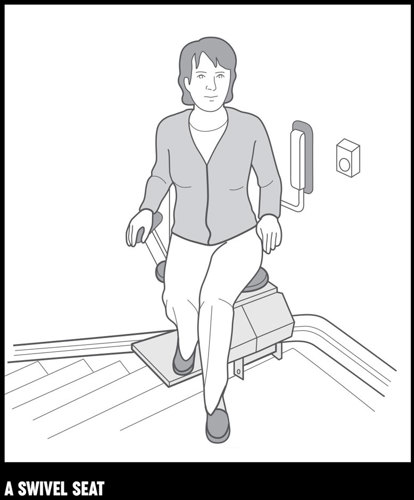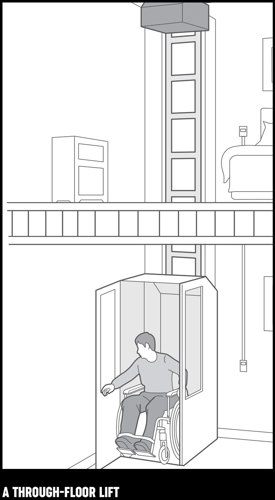
How do I choose a stairlift?
You’ll need a thorough assessment of both the layout of your home and your own physical ability in order to choose the best stairlift for you. These are some of the main points you should consider:
Unusual stairs
Is your stairway straight or curved? Several types of stairlift are available for stairs that curve either at the top or at the bottom.
Do you want a swivel seat?
Swivel seats are designed to make it safer to get off a stairlift. They work like an office chair and swivel at the top of the stairs so you end up facing the landing. These seats also have armrests for you to grip, making them easier to get out of. Swivel seats have a control, allowing the chair to swivel when you want it to, but some people with hand, arm or wrist problems find these difficult to use, so the 'try before you buy' rule applies.

Doorway problems
If a door or passage at the top or bottom of the stairs could be blocked by the stairlift track, there are a number of models designed to overcome this problem. But remember that if you choose a model whose track stops short of the top of the stairs, the lift will also stop short of the top. This might make getting off dangerous. A folding track is available for the bottom to give access to a doorway, but you’ll need to make sure that you’re able to fold and unfold it.
Folding and unfolding the chair
Some stairlifts make it difficult for others in the house to climb the stairs. In these cases the footplate, seat and armrests need to be folded out of the way. You can select a design where the footplate and armrests automatically lift out of the way when the seat is folded up. Some models need the user to push the seat up, so you should check that you’re able to do this if necessary, but other types can lift the seat using the remote control. If you want to be able to fold the footplate yourself, check that you can do so safely and easily, as you may have to do it several times a day. Be aware that folding and unfolding the footplate can be tricky or even dangerous, especially at the top of the stairs.
Your physical problems
Hand or wrist problems can make it difficult to keep the drive button pressed for the whole trip. You may find using a joystick easier. Check that you can easily use both this and any lever that allows the seat to swivel.
If you have any hip, knee or back problems the height of the stairlift seat is important. Check that it’s right for you at both the top and bottom of the stairs. Some people find a swivel seat with sturdy armrests easier to use because they can use the arms to push up from. If you’re unable to sit upright because of your arthritis, check that your knees or feet won’t get caught against the opposite wall or banisters, as this could be dangerous. Curved-rail lifts have to cut the corner on bends, which may mean that your knees brush against the staircase post.
Don’t take a stick or walking frame (Zimmer) with you on the stairlift. It might catch on the steps or banisters while the lift is moving. Get another walking aid so you can have one at the top of the stairs and one below. A handrail near the stairlift may also be useful if you feel unsteady on your feet.
Can I use a stairlift if I use a wheelchair?
Advances in treatment mean it’s now less common that people with arthritis will have to use a wheelchair in the home, but if you use a wheelchair you’ll need to look at the lift options slightly differently. You might want to look at a conventional stairlift, a wheelchair platform stairlift or perhaps a through-floor lift.
Conventional stairlift
Things to think about:
- How will you get out of your wheelchair and onto the stairlift?
- Is there enough room at the top and bottom of the stairs to get the wheelchair close enough to the stairlift? (This will depend on how you get on and off – whether you’re able to stand and maybe take a step before getting on.)
- Will you need one wheelchair upstairs and another downstairs?
- If you need help transferring from wheelchair to lift, is there enough space for a helper, wheelchair and you?
Discuss these issues with your family and the stairlift company representative.
Wheelchair platform stairlift
There are models of stairlift specifically designed to take a wheelchair. A sunken area may need to be built at the bottom of the stairs to take the platform and provide level access. This has many advantages if you find it difficult to move from a wheelchair onto a stairlift seat. You’ll need to make sure there’s enough space top and bottom, not just for the platform but also turning room so that you can easily get the chair on and off. You should also think about whether others in the house will be inconvenienced by the platform.
Through-floor lift
If there isn’t enough room at the top or bottom of the stairs for either a stairlift or wheelchair platform, a through-floor lift is the best solution. This can be placed in a living room or hall and go through the ceiling to a landing or bedroom. Get professional advice and try before you decide to buy.

Will a stairlift affect other people in the house?
Families quickly get used to lifts and almost forget they’re there. But there are a few points to consider:
Stairlifts run on a track, which cuts down the amount of space for other people climbing the stairs, especially at corners. The track may stick out at the bottom of the stairs and the seat or footplate may be a hazard. However, stairlifts are designed to stop immediately if they encounter any object or person on the stairs.
Through-floor lifts and wheelchair platform stairlifts have safety devices that stop anyone from being crushed when the platform comes down. If you think you may have trouble with young children or pets there are models that can be turned off with a key. Safety devices on all lifts prevent children from being trapped, and fingers are protected from moving parts by guards. Be aware that the positioning of the track usually means you can’t put a safety gate at the bottom of the stairs.
Using a lift with a helper
You may need a helper to use a lift. After a few tries you and your helper will probably develop a smooth, trouble-free routine. One thing to note is that at some point the helper will need to get past a stairlift so they’ll be in a position to help you off at the other end. It’s usually better for the helper to get past at the bottom of the stairs, in case of a fall.
How much does a stairlift cost?
The cost of a chair lift varies depending on the size, shape, and any additional requirements.
Financial help to buy a stairlift may be available via the National Disability Insurance Scheme (NDIS) for people aged under 65 years or MyAgedCare (call 1800 200 422) if you are 65 or older.
If your lift is no longer needed
It’s usually quite easy to have lifts removed when they’re no longer needed. Usually the only lifts that can easily be resold are stairlifts with a straight track, because curved-rail stairlifts often won’t fit anywhere else. Seek advice from the manufacturer.
Stairlift breakdowns and safety
It’s extremely rare for lifts to stop working in the middle of a journey, but monitoring alarms are available if you want one. These have a small transmitter with a button, which will contact an emergency monitoring centre when pressed. Some people carry a cordless or mobile phone on the lift.
If you live on your own, we recommend putting a phone extension on the upper floor, just in case the lift isn’t working when you need to use it.
The safety record of stairlifts and homelifts is good. There are few breakdowns, and accidents are extremely rare.










